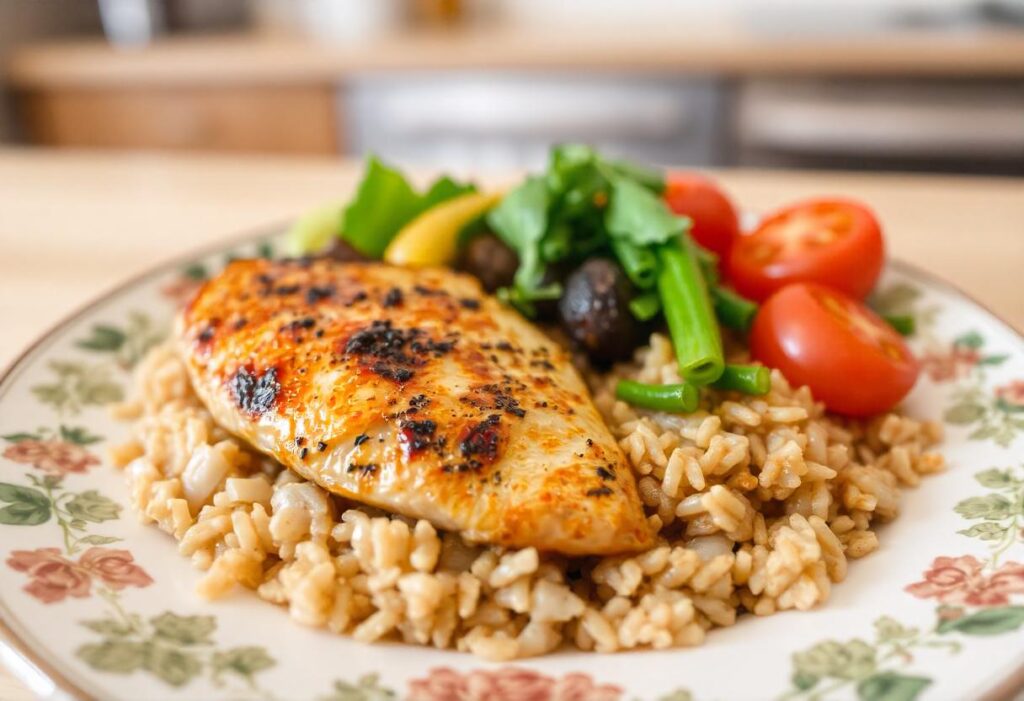Burn Fat and Gain Muscle: Effective Strategies for Body Recomposition.
Fat loss and muscle gain are common fitness goals. Many people aim to shed excess body fat while building lean muscle mass. The right diet and exercise approach can achieve this dual objective.
Proper nutrition and resistance training play key roles in transforming body composition. Individuals can work towards burning fat and increasing muscle by focusing on strength exercises and optimizing protein intake.
A well-designed program can help maximize results and improve overall fitness.
Key Takeaways
- Nutrition and resistance training are crucial for body recomposition
- Strength exercises are more effective than cardio for muscle gain
- A balanced approach targets both fat loss and muscle growth
5 Strategies to Reduce Body Fat and Increase Muscle Mass

One: Consume Adequate Protein
Protein plays a crucial role in muscle development and satiety. It helps maintain stable blood sugar levels throughout the day, reducing the urge to snack frequently.
A higher protein intake may be necessary for weight training compared to the average person. It’s advisable to gradually increase protein consumption as one becomes more accustomed to training volume, improves lifting capacity, and reduces body fat.
Two: Alternate Between Intensity and Volume in Workouts
Structuring weight training programs to focus on strength and muscle mass can lead to optimal aesthetic results while minimizing the risk of injury or muscular imbalances.
A recommended approach is to dedicate 1-2 weeks per month to hypertrophy training (moderate weight with higher repetitions) and then transition to strength building (heavier weights with fewer repetitions). This alternating strategy has proven effective for many individuals.
Three: Incorporate Intermittent Fasting
Intermittent fasting can enhance insulin sensitivity, allowing the body to utilize food more efficiently for muscle-building and energy production. This approach may help direct nutrients towards muscle growth rather than fat storage.
Many find intermittent fasting an effective method for improving body composition by reducing body fat while supporting muscle development.

Four: Prioritize Compound Exercises
Exercises that engage multiple joints and muscle groups simultaneously, such as:
- Deadlifts
- Squats
- Lunges
- Bench presses
- Pull-ups
Due to the number of muscles involved and the exertion required, these movements offer significant potential for muscle growth and fat loss. Proper form and a full range of motion are essential to maximize the benefits of these exercises.
Five: Adjust Lifting Speed and Tempo
The speed at which exercises are performed can impact body composition. For optimal results, consider the following tempo guidelines:
| Phase | Duration | Description |
|---|---|---|
| Eccentric | 3-6 seconds | Lowering the weight |
| Concentric | Faster | Lifting the weight |
Focusing on longer eccentric phases can increase time under tension, potentially leading to greater metabolic adaptations. These adaptations may include increases in muscle glycogen, creatine phosphate, and ATP, which are beneficial for altering body composition.

Common Questions About Fat Loss and Muscle Gain
Signs of Concurrent Muscle Growth and Fat Reduction
Building muscle while losing fat can be tricky to spot. Key indicators include:
- Clothes fitting differently, especially looser around the waist
- Increased strength in workouts
- Body measurements changing (waist shrinking, arms/legs growing)
- Scale weight staying stable while body composition improves
These changes often happen slowly. Taking progress photos and measurements can help track improvements over time.
Nutrition Guidelines for Women Seeking Muscle Growth and Fat Loss
Women aiming to build muscle and lose fat should focus on:
- Adequate protein intake (1.6-2.2g per kg of body weight daily)
- Moderate calorie deficit (10-20% below maintenance)
- Balanced meals with lean proteins, complex carbs, and healthy fats
- Timing protein intake around workouts
- Staying hydrated
Consistency with nutrition is key for seeing results.
Weekly Meal Plan Supporting Muscle Gain and Fat Loss
Here’s a basic 7-day meal plan template:
| Meal | Mon-Wed-Fri | Tue-Thu-Sat | Sun |
|---|---|---|---|
| Breakfast | Egg white omelette with veggies | Greek yogurt with berries and nuts | Whole grain toast with avocado and smoked salmon |
| Snack | Apple with almond butter | Protein shake | Carrot sticks with hummus |
| Lunch | Grilled chicken salad | Tuna wrap with mixed greens | Lentil soup with side salad |
| Snack | Cottage cheese with cucumber | Hard-boiled eggs | Rice cakes with peanut butter |
| Dinner | Lean beef stir-fry with brown rice | Baked fish with quinoa and asparagus | Turkey meatballs with zucchini noodles |
Adjust portions and specific foods based on individual needs and preferences.
Workout Plan for Combined Weight Loss and Muscle Growth
A balanced plan might include:
- Strength training 3-4 times per week
- Focus on compound exercises (squats, deadlifts, bench press)
- Progressive overload to continually challenge muscles
- High-Intensity Interval Training (HIIT) 2-3 times per week
- Short, intense bursts of activity followed by rest
- Examples: sprints, burpees, mountain climbers
- Low-intensity steady-state cardio 1-2 times per week
- Helps with recovery and overall cardiovascular health
- Examples: walking, swimming, cycling
- Rest days for recovery and muscle repair
Time Frame Comparison: Fat Burning vs. Muscle Gain
Fat loss can often occur more quickly than muscle gain. Generally:
- Noticeable fat loss: 4-8 weeks with proper diet and exercise
- Visible muscle gain: 8-12 weeks of consistent training and nutrition
Individual results vary based on genetics, starting point, and adherence to diet and exercise plans.
Nutritional Approaches for Simultaneous Fat Loss and Muscle Growth
To support both goals:
- Maintain a slight calorie deficit (10-20% below maintenance)
- Consume adequate protein (1.6-2.2g per kg of body weight)
- Time carbohydrates around workouts for energy
- Include healthy fats for hormone production
- Stay hydrated to support metabolic processes
- Consider supplements like creatine or protein powder if needed
